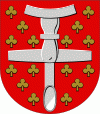Paimio
 |
It is located in the province of Western Finland and is part of the Southwest Finland region. The municipality has a population of 0 and covers an area of undefined km2 of which undefined km2 is water. The population density is undefined PD/km2. The municipality is unilingually Finnish.
Paimio centre is called Vista, divided by the church hill to Upper Vista (Ylä-Vista) and Lower Vista (Ala-Vista).
Paimio is best known for Paimio Sanatorium operating as a part of Turku University Hospital. It was built in 1932 and designed by architect Alvar Aalto and originally served as a tuberculosis sanatorium.
Map - Paimio
Map
Country - Finland
 |
 |
| Flag of Finland | |
Finland was first inhabited around 9000 BC after the Last Glacial Period. The Stone Age introduced several different ceramic styles and cultures. The Bronze Age and Iron Age were characterized by contacts with other cultures in Fennoscandia and the Baltic region. From the late 13th century, Finland became a part of Sweden as a consequence of the Northern Crusades. In 1809, as a result of the Finnish War, Finland became part of the Russian Empire as the autonomous Grand Duchy of Finland, during which Finnish art flourished and the idea of independence began to take hold. In 1906, Finland became the first European state to grant universal suffrage, and the first in the world to give all adult citizens the right to run for public office. After the 1917 Russian Revolution, Finland declared independence from Russia. In 1918, the fledgling state was divided by the Finnish Civil War. During World War II, Finland fought the Soviet Union in the Winter War and the Continuation War, and Nazi Germany in the Lapland War. It subsequently lost parts of its territory, but maintained its independence.
Currency / Language
| ISO | Currency | Symbol | Significant figures |
|---|---|---|---|
| EUR | Euro | € | 2 |
| ISO | Language |
|---|---|
| FI | Finnish language |
| SV | Swedish language |
















